Plant Water Use Strategy in Response to Spatial and Temporal Variation in Precipitation Patterns in China: A Stable Isotope Analysis
Abstract
:1. Introduction
2. Materials and Methods
3. Results and Discussion
3.1. The Relationship between δD and δ18O
3.1.1. Meteoric Water Line
3.1.2. Plant Stem Water Line
3.1.3. Soil Water Line
3.2. Plant Main Water Source
3.3. Contribution of the Plant Main Water Source
4. Conclusions
Acknowledgments
Author Contributions
Conflicts of Interest
Appendix A
- Ma, H.Y.; Yang, X.D.; Lv, G.H.; He, X.M.; Zhang, X.N.; Wang, X.Y.; Li, Y. Water sources of dominant desert species in ebinur lake wetland nature reserve, Xinjiang, China. Acta Ecologica Sinica 2017, 37, 829–840.
- Zhou, H.; Zheng, X.J.; Tang, L.S.; Li, Y. Differences and similarities between water sources of Tamarix ramosissima, Nitraria sibirica and Reaumuria soongorica in the southeastern Junggar Basin. Chinese Journal of Plant Ecology 2013, 37, 665–673.
- Zhu, Y.J.; Jia, Z.Q. Water Source of Haloxylon ammodendron plantations in autumn at the southeast edge of Badain Jaran Desert. Scientia Silvae Sinicae 2012 48, 1–5.
- Zhu, L.; Xu, X.; Mao, G.L. Water sources of shrubs grown in the northern Ningxia Plain of China characterized by shallow groundwater table. Chinese Journal of Plant Ecology 2012, 36, 618–628.
- Gong, G.L.; Chen, H.; Duan, D.Y. Comparison of the methods using stable hydrogen and oxygen isotope to distinguish the water source of Nitraria tangutorum. Acta Ecologica Sinica 2011, 31, 7533–7541.
- Wang, Y.L.; Liu, L.C.; Gao, Y.H.; Li, G.; Zhao, J.C.; Xie, M. Analysis of water sources of plants in artificial sand-fixation vegetation area based on large rainfall events. Chinese Journal of Applied Ecology 2016, 27, 1053–1060.
- Yin, L.; Zhao, L.J.; Ruan, Y.F.; Xiao, H.L.; Cheng, G.D.; Zhou, M.X.; Wang, F.; Li, C.Z. Study of the replenishment sources of typical ecosystems water and dominant plant water in the lower reaches of the Heihe, China. Journal of Glaciology and Geocryology 2012, 34, 1478–1486.
- Xing, X.; Chen, H.; Zhu, J.J.; Chen, T.T. Water sources of five dominant desert plant species in Nuomuhong area of Qaidam Basin. Acta Ecologica Sinica 2014, 34, 6277–6286.
- Wu, Y.; Zhou, H.; Zheng, X.J.; Li, Y.; Tang, L.S. Seasonal changes in the water use strategies of three co-occurring desert shrubs. Hydrological Processes 2015, 28, 6265–6275.
- Dai, Y.; Zheng, X.J.; Tang, L.S.; Li, Y. Dynamics of water usage in Haloxylon ammodendron in the southern edge of the Gurbantünggüt Desert. Chinese Journal of Plant Ecology 2014, 38, 1214–1225.
- Cui, Y.Q.; Ma, J.Y.; Feng, Q.; Sun, J.H.; Sun, W. Water sources and water-use efficiency of desert plants in different habitats in Dunhuang, NW China. Ecological Research 2017, 32, 243–258.
- Li, H.; Liang, X.; liu, Y. F.; Liu, Y.L.; Iian, Y. Application of hydrogen and oxygen stable isotopes for determining water sources used by cotton in Xinjiang arid region. Earth Science 2017, 42, 843–852.
- Zhu, Y.; Jia, Z.; Yang, X. Resource-dependent water use strategy of two desert shrubs on interdune, Northwest China. Journal of Food Agriculture and Environment 2011, 9, 832–835.
- Zhao, L.J.; Xiao, H.L.; Cheng, G.D.; Song, Y.X.; Zhao, L.; Li, C.Z.; Yang, Q. A preliminary study of water sources of riparian plants in the lower reaches of the Heihe Basin. Acta Geoscientiva Sinica 2008, 29, 709–718.
- Chen, J.; Xu, Q.; Gao, D.Q.; Ma, Y.B. Water use of Helianthemum songaricum and co-occurring plant species Sarcozygium xanthoxylum in western ordos. Scientia Silvae Sinicae 2016, 52, 48–56.
- Zhu, L.; Qi, Y.S.; Xu, X. Water sources of Medicago sativa grown in different slope positions in Yanchi county of Ningxia. Chinese Journal of Plant Ecology 2014, 38, 1226–1240.
- Zheng, X.R.; Zhao, G.Q.; Li, X.Y.; Li, L.; Wu, H.W.; Zhang, S.Y.; Zhang, Z.H. Application of stable hydrogen isotope in study of water sources for Caragana microphylla bushland in Nei Mongol. Chinese Journal of Plant Ecology 2015, 39, 184–196.
- Wu, H.W.; Li, X.Y.; Jiang, Z.Y.; Li, J.; Zheng, X.R.; Zhao, D.Z. Variations in water use for Achnatherum splendens in Qinghai Lake watershed, based on δD and δ18O. Acta Ecologica Sinica 2015, 35, 8174–8183.
- Liu, B.Q.; Liu, Z.M.; Qian, J.Q.; Alamusa; Zhang, F., L. Water sources of dominant sand-binding plants in dry season in southern Horqin Sandy Land, China. Chinese Journal of Applied Ecology 2017, 28, 2093–2101.
- Zhou, H.; Zhao, W.Z.; He, Z.B. Water sources of Nitraria sibirica and response to precipitation in two desert habitats. Chinese Journal of Applied Ecology 2017, 28, 2083–2092.
- Liu, L.Y.; Jia, Z.Q.; Zhu, Y.J.; Li, H.; Yang, D.F.; Wei, D.X.; Zhao, X.B. Water use strategy of Salix cheilophila stands with different ages in Gonghe Basin, Qinghai Province. Forest Research 2012, 25, 597–603.
- Zhao, G.Q.; Li, X.Y.; Wu, H.W.; Zhang, S.Y.; Li, G.Y. Study on plant water use in Myricaria squamosa with stable hydrogen isotope tracer in Qinghai Lake basin. Chinese Journal of Plant Ecology 2013, 37, 1091–1100.
- Fang, J.; Wei, Y.F.; Liu, S.; Zhao, X.Y.; Li, S.G. Stable isotopic analysis on water utilization sources of Pinus sylvestris var. mongolica plantations in inter-dune lowland in Horqin Sandy Land. Chinese Journal of Ecology 2011, 30, 1184–1900.
- Song, L.; Zhu, J.; Li, M.; Yu, Z. Water utilization of Pinus sylvestris var. mongolica in a sparse wood grassland in the semiarid sandy region of Northeast China. Trees 2014, 28, 971–982.
- Su, H.; Li, Y.; Liu, W.; Xu, H.; Sun, O.J. Changes in water use with growth in Ulmus pumila in semiarid sandy land of northern China. Trees 2014, 28, 41–52.
- Jia, Z.; Zhu, Y.; Liu, L. Different water use strategies of juvenile and adult caragana intermedia plantations in the Gonghe Basin, Tibet Plateau. PLoS ONE 2012, 7, e45902.
- Li, J.; Wu, H.W.; Li, X.Y.; He, B.; Pei, T.T.; Jiang, Z.Y.; Bao, Z.C. Water utilizations by crops in the cropland ecosystem, Qinghai Lake Watershed. Journal of Natural Resources 2017, 32, 1348–1359.
- Liu, Z.Q.; Yu, X.X.; Lou, Y.H.; Li, H.Z.; Jia, G.D.; Lu, W.W., Water use strategy of Platycladus orientalis in Beijing mountainous area. Acta Ecologica Sinica 2016, 37, 3697–3705.
- Liu, Z.Q.; Yu, X.X.; Jia, G.D.; Li, H.Z.; Lu, W.W. Water source of typical plants in rocky mountain area of Beijing, China. Chinese Journal of Applied Ecology 2017, 28, 2135–2142.
- Liu, Z.Q.; Yu, X.X.; Jia, G.D.; Jia, J.B.; Lou, Y.H.; Zhang, K. Water use characteristics of Platycladus orientalis and Quercus variabilis in Beijing mountain area. Scientia Silvae Sinicae 2016, 52, 22–30.
- Yang, G.M.; Wang, L. Water Use Patterns of two typical plants based on hydrogen and oxygen stable isotopes at Dumping site in the opencast coal mining area of Heidaigou. Journal of Natural Resources 2016, 31, 477–487.
- Sun, S.J.; Meng, P.; Zhang, J.S.; Huang, H.; Wan, X.C. Deuterium isotope variation and water use in an agroforestry system in the rocky mountainous area of North China. Acta Ecologica Sinica 2010, 30, 3717–3726.
- Zhang, T.G.; Li, Z.B.; Li, P.; Xu, G.C.; Liu, X.J.; Jin, Y.R. Response characteristics of soil water use patterns by different plants to precipitation in rocky mountainous areas. Chinese Journal of Applied Ecology 2016, 27, 1461–1467.
- Sun, S.J.; Meng, P.; Zhang, J.; Wan, X.C. Seasonal variation in water use of Ziziphus jujuba in the south aspect of Taihang Mountains with deuterium isotope signature. Scientia Silvae Sinicae 2011, 47, 46–53.
- Q, X.; Y, W. H.; R, l. S. Water use strategies of Malus toringoides and its accompanying plant species Berberis aemulans. Acta Ecologica Sinica 2011, 31, 5702–5710.
- Zhu, J.F.; Liu, J.T.; Lu, Z.H.; Sun, J.K.; Xia, J.B. Water use patterns of Tamarix chinensis in shell island wetlands of the Yellow River Delta. Wetland Science 2015, 13, 765–771.
- Wang, P.; Song, X.F.; Yuan, R.Q.; Han, D.M.; Zhang, Y.H.; Zhang, B. Study on water consumption law of summer corn in north China using deuterium and oxygen-18 isotopes. Journal of Natural Resources 2013, 28, 481–491.
- Zhang, C.; Zhang, J.; Zhao, B.; Zhu, A.; Hui, Z.; Ping, H.; Li, X. Coupling a two-tip linear mixing model with a δD– δ 18O plot to determine water sources consumed by maize during different growth stages. Field Crops Res. 2011, 123, 196–205.
- Wang, J.; Fu, B.; Lu, N.; Zhang, L. Seasonal variation in water uptake patterns of three plant species based on stable isotopes in the semi-arid Loess Plateau. Sci. Total Environ. 2017, 609, 27–37.
- Shao, H.; Zhu, J.F.; Liu, J.T.; Lu, Z.H.; Xia, J.B.; Sun, J.K.; Zhao, Y.Y. Soil-water interacting use patterns driven by Ziziphus jujube on the Chenier Island in the Yellow River Delta, China. Archives of Agronomy and Soilence 2016, 62, 1614–1624.
- Guo, F.; Ma, J.J.; Zheng, L.J.; Sun, X.H.; Guo, X.H.; Zhang, X.L. Estimating distribution of water uptake with depth of winter wheat by hydrogen and oxygen stable isotopes under different irrigation depths. Journal of Integrative Agriculture 2016, 15, 891–906.
- Wang, B.Y.; Chen, B.Z.; Sun, S.B.; Zhou, Z.Y.; Yang, Z.Q.; Liu, Y.Q.; Zhang, J.W. The water-use characteristics of summer corn during growing period in Yuchen, Shandong Province. J. Soil Water Conserv. 2016, 30, 153–161.
- Deng, W.P.; Yu, X.X.; Jia, G.D.; Li, Y.J.; Liu, Y.J. Water sources of three typical plants in the Beijing mountain areas in rainy season. Arid Zone Research 2014, 31, 649–657.
- Chen, Y.J.; Cao, K.F.; Schnitzer, S.A.; Fan, Z.X.; Zhang, J.L.; Bongers, F. Water-use advantage for lianas over trees in tropical seasonal forests. New Phytol. 2015, 205, 128–136.
- Deng, Y.; Jiang, Z.; Qin, X. Water source partitioning among trees growing on carbonate rock in a subtropical region of Guangxi, China. Environ. Earth Sci. 2012, 66, 635–640.
- Shen, Y.J.; Zhang, Z.B.; Gao, L.; Peng, X. Evaluating contribution of soil water to paddy rice by stable isotopes of hydrogen and oxygen. Paddy and Water Environment 2015, 13, 125–133.
- Liu, W.J.; Liu, W.Y.; Li, P.J.; Duan, W.P.; Li, H.M. Dry season water uptake by two dominant canopy tree species in a tropical seasonal rainforest of Xishuangbanna, SW China. Agric. Forest Meteorology 2010, 150, 380–388.
- Zhu, X.Q.; Fan, T.; Guan, W.; Qin, N. Soil-water utilization levels in a Cyclobalanopsis glaucoides virgin forest on the central Yunnankarst plateau. Journal of Zhejiang A and F University 2014, 31, 690–696.
- Deng, X.Q.; Wang, S.J.; Rong, L. Study on water sources of proper plant species in karst areas. Earth and Environment 2012, 40, 154–160.
- Ding, Y.L.; Chen, H.S.; Nie, Y.P.; Wang, S.; Zhang, H.L.; Wang, K.L. Water use strategy of Eucalyptus urophylla × E. grandis on karst hillslope based on isotope analysis. Chinese Journal of Applied Ecology 2016, 27, 2729–2736.
- Xu, Q.; Liu, S.R.; An, S.Q.; Jiang, Y.X.; Lin, G.H. Characteristics of hydrogen stable isotope in soil water of sub-alpine dark coniferous forest in Wolong, Sichuan Province. Scientia Silvae Sinicae 2007, 43, 8–14.
- Wu, J.N.; Liu, W.J.; Chen, C.F. How do plants share water sources in a rubber-tea agroforestry system during the pronounced dry season? Agric. Ecosyst. Environ. 2017, 236, 69–77.
- Song, L.N.; Zhu, J.J.; Li, M.C.; Zhang, J.X.; Lv, L.Y., Sources of water used by Pinus sylvestris var. mongolica trees based on stable isotope measurements in a semiarid sandy region of northeast China. Agric. Water Manag. 2016, 164, 281–290.
Appendix B
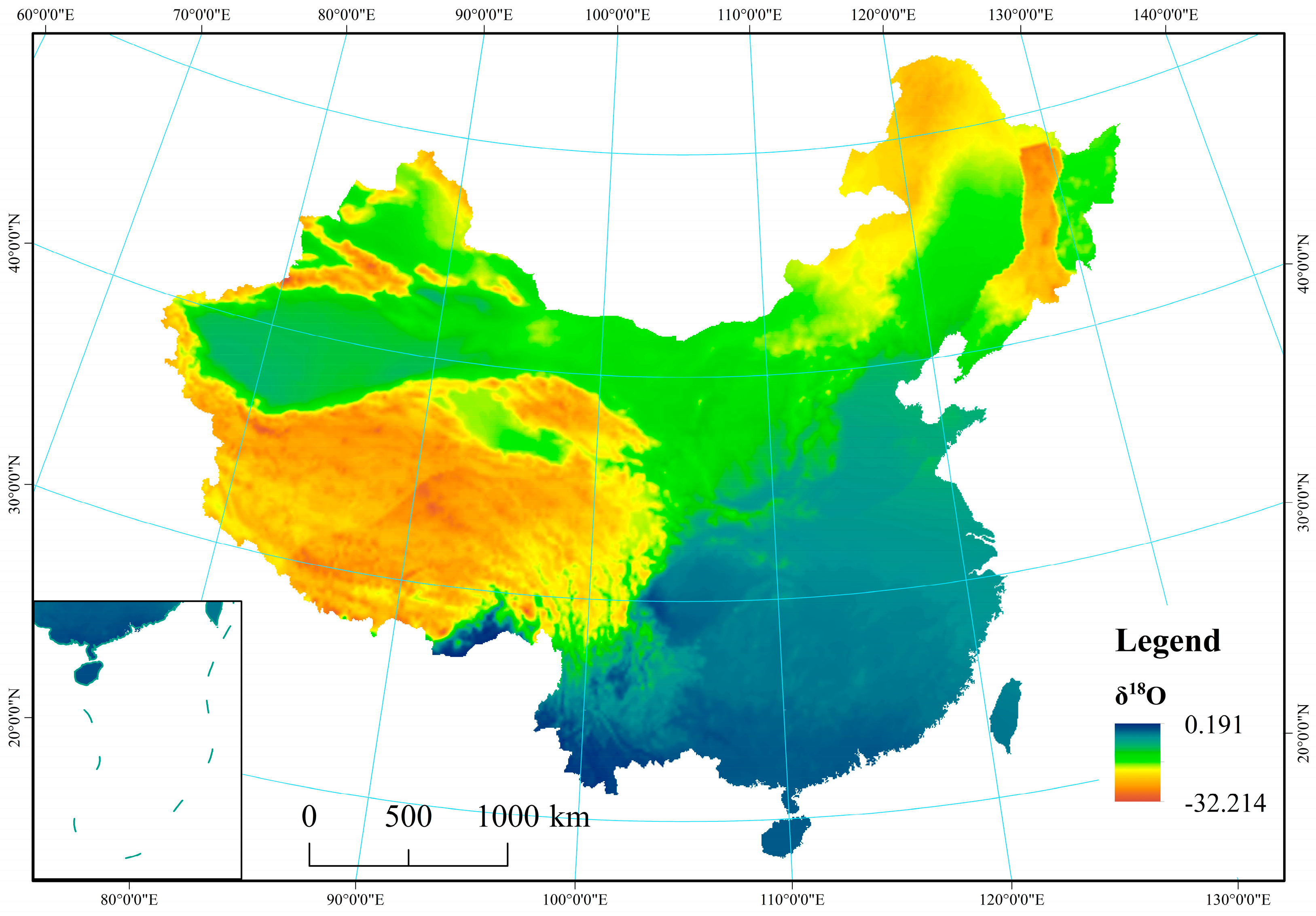
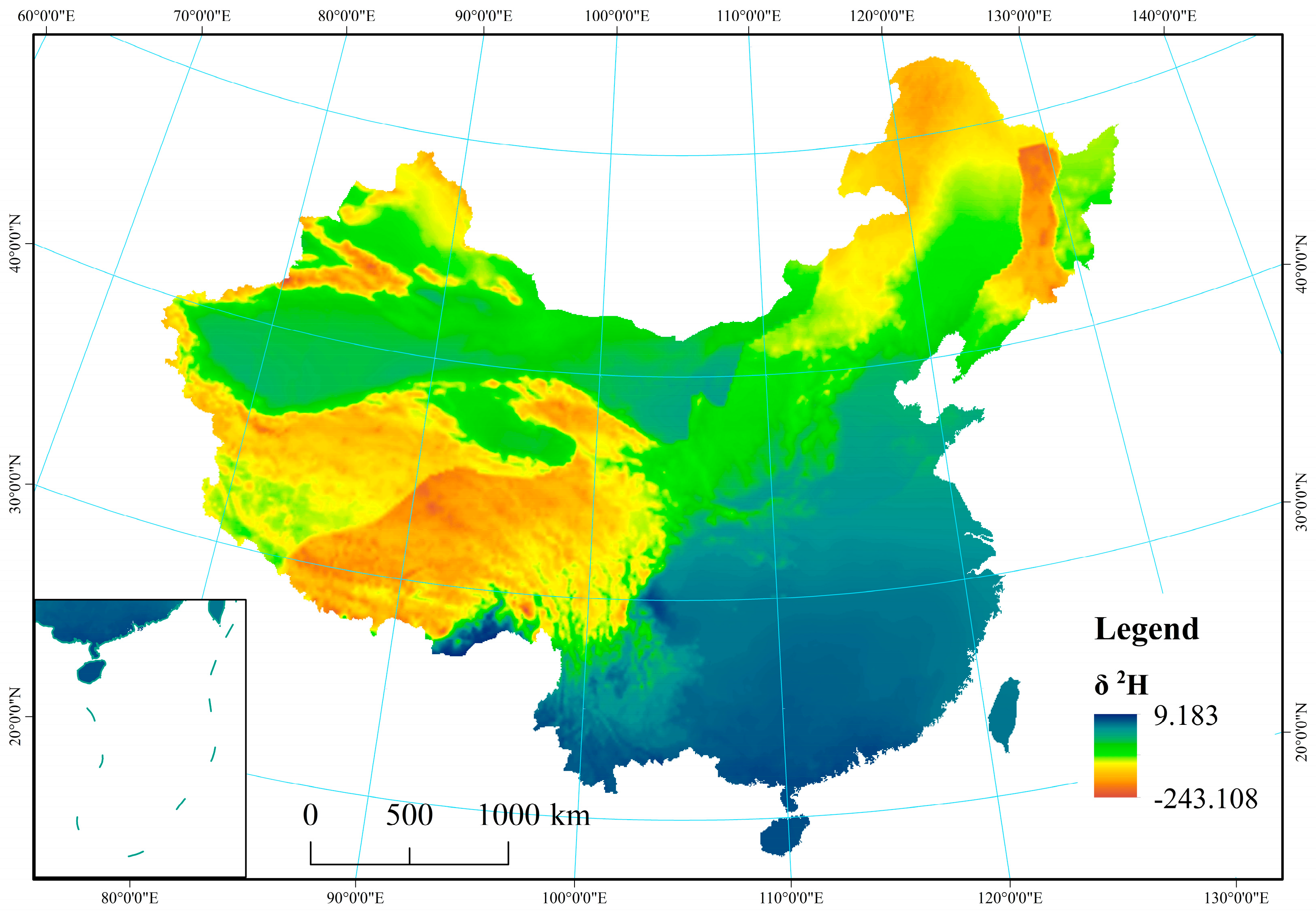
References
- West, J.B.; Bowen, G.J.; Cerling, T.E.; Ehleringer, J.R. Stable isotopes as one of nature’s ecological recorders. Trends Ecol. 2006, 21, 408–414. [Google Scholar] [CrossRef] [PubMed]
- Craig, H. Isotopic Variations in Meteoric Waters. Science 1961, 133, 1702–1703. [Google Scholar] [CrossRef] [PubMed]
- Bowen, G.J.; Wilkinson, B. Spatial distribution of δ18O in meteoric precipitation. Geology 2002, 30, 315–318. [Google Scholar] [CrossRef]
- Bowen, G.J.; Revenaugh, J. Interpolating the isotopic composition of modern meteoric precipitation. Water Resour. Res. 2003, 39, 1299. [Google Scholar] [CrossRef]
- Dansgaard, W. Stable isotope in precipitation. Tellus 1964, 16, 436–468. [Google Scholar] [CrossRef]
- Loik, M.E.; Breshears, D.D.; Lauenroth, W.K.; Belnap, J. A multi-scale perspective of water pulses in dryland ecosystems: Climatology and ecohydrology of the western USA. Oecologia 2004, 141, 269. [Google Scholar] [CrossRef] [PubMed]
- Du, B.; Kang, H.; Zhu, Y.; Zhou, X.; Yin, S.; Burgess, P.J.; Liu, C. Variation of oriental oak (Quercus variabilis) leaf δ13C across temperate and subtropical China: Spatial patterns and sensitivity to precipitation. Forests 2015, 6, 2296–2306. [Google Scholar] [CrossRef] [Green Version]
- Flanagan, L.B.; Ehleringer, J.R. Stable isotope composition of stem and leaf water: Applications to the study of plant water use. Funct. Ecol. 1991, 5, 270–277. [Google Scholar] [CrossRef]
- Xu, Q.; Li, H.; Chen, J.; Cheng, X.; Liu, S.; An, S. Water use patterns of three species in subalpine forest, Southwest China: The deuterium isotope approach. Ecohydrology 2011, 4, 236–244. [Google Scholar] [CrossRef]
- Rossatto, D.R.; de Carvalho Ramos Silva, L.; Villalobos-Vega, R.; Sternberg, L.D.S.L.; Franco, A.C. Depth of water uptake in woody plants relates to groundwater level and vegetation structure along a topographic gradient in a neotropical savanna. Environ. Exp. Bot. 2012, 77, 259–266. [Google Scholar] [CrossRef]
- Schwinning, S.; Starr, B.I.; Ehleringer, J.R. Summer and winter drought in a cold desert ecosystem (Colorado Plateau) part I: Effects on soil water and plant water uptake. J. Arid Environ. 2005, 60, 547–566. [Google Scholar] [CrossRef]
- Schachtschneider, K.; February, E.C. The relationship between fog, floods, groundwater and tree growth along the lower Kuiseb River in the hyperarid Namib. J. Arid Environ. 2010, 74, 1632–1637. [Google Scholar] [CrossRef]
- Rong, L.; Wang, S.J.; Yu, G.S.; Deng, X.Q.; Ran, J.C. Stable isotope analysis of water sources of four woody species in the Libo karst forest. Sci. Silvae Sin. 2012, 48, 14–22. [Google Scholar]
- Fu, P.L.; Liu, W.J.; Fan, Z.X.; Cao, K.F. Is fog an important water source for woody plants in an Asian tropical karst forest during the dry season? Ecohydrology 2016, 9, 964–972. [Google Scholar] [CrossRef]
- Querejeta, J.I.; Estrada-Medina, H.; Allen, M.F.; Jimenez-Osornio, J.J. Water source partitioning among trees growing on shallow karst soils in a seasonally dry tropical climate. Oecologia 2007, 152, 26–36. [Google Scholar] [CrossRef] [PubMed]
- Schwinning, S.; Sala, O.E.; Loik, M.E.; Ehleringer, J.R. Thresholds, memory, and seasonality: Understanding pulse dynamics in arid/semi-arid ecosystems. Oecologia 2004, 141, 191–193. [Google Scholar] [CrossRef] [PubMed]
- West, A.G.; Hultine, K.R.; Burtch, K.G.; Ehleringer, J.R. Seasonal variations in moisture use in a piñon–juniper woodland. Oecologia 2007, 153, 787–798. [Google Scholar] [CrossRef] [PubMed]
- Nie, Y.P.; Chen, H.S.; Wang, K.L.; Tan, W.; Deng, P.Y.; Yang, J. Seasonal water use patterns of woody species growing on the continuous dolostone outcrops and nearby thin soils in subtropical China. Plant Soil 2011, 341, 399–412. [Google Scholar] [CrossRef]
- Schwinning, S.; Starr, B.I.; Ehleringer, J.R. Dominant cold desert plants do not partition warm season precipitation by event size. Oecologia 2003, 136, 252–260. [Google Scholar] [CrossRef] [PubMed]
- Sun, S.J.; Meng, P.; Zhang, J.S.; Wan, X.C. Variation in soil water uptake and its effect on plant water status in Juglans regia L. during dry and wet seasons. Tree Physiol. 2011, 31, 1378–1389. [Google Scholar] [CrossRef] [PubMed]
- Ren, G.Y.; Zhan, Y.J.; Ren, Y.Y.; Chen, Y.; Wang, T.; Liu, Y.J.; Sun, X.B. Spatial and temporal patterns of precipitation variability over mainland China: I. Climatology. Adv. Water Sci. 2015, 26, 299–310. [Google Scholar]
- Huang, B.W. Comprehensive natural regionalization preliminary draft of China. Acta Geogr. Sin. 1958, 24, 348–365. [Google Scholar]
- Wu, S.H.; Yang, Q.Y.; Zheng, D. Delineation of eco-geographic regional system of China. J. Geogr. Sci. 2003, 13, 309–315. [Google Scholar]
- Mao, F.; Sun, H.; Yang, H.L. Research progress in dry/wet climate zoning. Prog. Geogr. 2011, 30, 17–26. [Google Scholar]
- Wu, H.; Li, X.-Y.; Jiang, Z.; Chen, H.; Zhang, C.; Xiao, X. Contrasting water use pattern of introduced and native plants in an alpine desert ecosystem, Northeast Qinghai-Tibet Plateau, China. Sci. Total Environ. 2016, 542, 182–191. [Google Scholar] [CrossRef] [PubMed]
- Wei, Y.F.; Fang, J.; Liu, S.; Zhao, X.Y.; Li, S.G. Stable isotopic observation of water use sources of Pinus sylvestris var. mongolica in Horqin Sandy Land, China. Trees 2013, 27, 1249–1260. [Google Scholar] [CrossRef]
- Song, L.; Zhu, J.; Li, M.; Zhang, J. Water use patterns of Pinus sylvestris var. mongolica trees of different ages in a semiarid sandy lands of Northeast China. Environ. Exp. Bot. 2016, 129, 94–107. [Google Scholar]
- Liu, S.B.; Chen, Y.N.; Chen, Y.P.; Friedman, J.M.; Hati, J.H.A.; Fang, G.H. Use of 2H and 18O stable isotopes to investigate water sources for different ages of Populus euphratica along the lower Heihe River. Ecol. Res. 2015, 30, 581–587. [Google Scholar] [CrossRef]
- Huang, M.S.; Du, X.N.; Liao, M.M.; Chen, L.Z.; Lin, G.H. Photosynthetic characteristics and water use strategies of coastal shelterbelt plant species in Southeast China. Chin. J. Ecol. 2012, 31, 2996–3002. [Google Scholar]
- Wang, P.Y.; Liu, W.J.; Li, J.T. Water use strategy of Ficus tinctoria in tropical rainforest region of Xishuangbanna, Southwestern China. Chin. J. Appl. Ecol. 2010, 21, 836–842. [Google Scholar]
- Deng, Y.; Kuo, Y.M.; Jiang, Z.; Qin, X.; Jin, Z. Using stable isotopes to quantify water uptake by Cyclobalanopsis glauca in typical clusters of karst peaks in China. Environ. Earth Sci. 2015, 74, 1039–1046. [Google Scholar] [CrossRef]
- West, A.G.; February, E.C.; Bowen, G.J. Spatial analysis of hydrogen and oxygen stable isotopes (“isoscapes”) in ground water and tap water across South Africa. J. Geochem. Explor. 2014, 145, 213–222. [Google Scholar] [CrossRef]
- Evaristo, J.; McDonnell, J.J. Prevalence and magnitude of groundwater use by vegetation: A global stable isotope meta-analysis. Sci. Rep. 2017, 7, 44110. [Google Scholar] [CrossRef] [PubMed]
- Zheng, S.H.; Hou, F.G.; Ni, B.L. A study on hydrogen and oxygen isotopes composition of precipitation in China. Chin. Sci. Bull. 1983, 28, 801–806. [Google Scholar]
- Liu, J.R.; Song, X.F.; Yuan, G.F.; Sun, X.X.; Liu, X.; Chen, F.; Wang, Z.M.; Wang, S.Q. Character istics of δ18O in precipitation over Northwest China andits water vapor sources. Acta Geogr. Sin. 2008, 63, 12–22. [Google Scholar]
- Huang, L.; Zhang, Z. Stable isotopic analysis on water utilization of two xerophytic shrubs in a revegetated desert area: Tengger Desert, China. Water 2015, 7, 1030–1045. [Google Scholar] [CrossRef]
- Duan, D.Y.; Hua, O.; Song, M.H.; Hu, Q.W. Water sources of dominant species in three alpine ecosystems on the Tibetan Plateau, China. J. Plant Sci. 2008, 50, 257–264. [Google Scholar] [CrossRef] [PubMed]
- Xing, X.; Chen, H.; Chen, T.T.; Han, L. Study of the water sources of Salsola abrotanoides under various precipitation conditions. J. Glaciol. Geocryol. 2015, 37, 1396–1405. [Google Scholar]
- Li, S.G.; Romero-Saltos, H.; Tsujimura, M.; Sugimoto, A.; Sasaki, L.; Davaa, G.; Oyunbaatar, D. Plant water sources in the cold semiarid ecosystem of the upper Kherlen River catchment in Mongolia: A stable isotope approach. J. Hydrol. 2007, 333, 109–117. [Google Scholar] [CrossRef]
- Liu, J.R.; Song, X.F.; Yuan, G.F.; Sun, X.M.; Liu, X.; Wang, S.Q. Characteristics of δ18O in precipitation over eastern monsoon China and the water vapor sources. Chin. Sci. Bull. 2009, 54, 3521–3531. [Google Scholar]
- Zhang, X.P.; Liu, J.M.; Masayoshi, N.; Xie, Z.C. Vapor origins revealed by deuterium excess in precipitation in Southwest China. J. Glaciol. Geocryol. 2009, 31, 31–37. [Google Scholar]
- Wu, X.D. Stable isotope compositions for meteoric water from Chengdu and their implication of climate. Acta Geol. Sin. 2009, 29, 52–54. [Google Scholar]
- Liu, W.J.; Li, P.J.; Li, H.M.; Zhang, Y.P.; Duan, W.P. Fog interception and its relation to soil water in the tropical seasonal rain forest of Xishuangbanna, Southwest China. Acta Ecol. Sin. 2006, 26, 9–15. [Google Scholar] [CrossRef]
- Tian, L.D.; Yao, T.D.; Zhang, Y.S.; Pu, J.C. Chemical characteristics of summer precipitation at Xixiabangma, Tibetan Plateau. Environ. Sci. 1998, 19, 1–5. [Google Scholar]
- Liu, Z.F.; Tian, L.D.; Yao, T.D.; Chai, X.R. Spatial distribution of δ18O in precipitation over China. Chin. Sci. Bull. 2009, 54, 804–811. [Google Scholar]
- Allison, G.B.; Hughes, M.W. The use of natural tracers as indicators of soil-water movement in a temperate semi-arid region. J. Hydrol. 1983, 60, 157–173. [Google Scholar] [CrossRef]
- Ellsworth, P.Z.; Williams, D.G. Hydrogen isotope fractionation during water uptake by woody xerophytes. Plant Soil 2007, 291, 93–107. [Google Scholar] [CrossRef]
- Dai, Y.; Zheng, X.J.; Tang, L.S.; Li, Y. Stable oxygen isotopes reveal distinct water use patterns of two Haloxylon species in the Gurbantonggut Desert. Plant Soil 2015, 389, 73–87. [Google Scholar] [CrossRef]
- Zhang, C.; Li, X.; Wu, H.; Wang, P.; Wang, Y.; Wu, X.; Li, W.; Huang, Y. Differences in water-use strategies along an aridity gradient between two coexisting desert shrubs (Reaumuria soongorica and Nitraria sphaerocarpa): Isotopic approaches with physiological evidence. Plant Soil 2017, 1–19. [Google Scholar] [CrossRef]
- Zhou, H.; Zhao, W.Z.; Zhang, G.F. Varying water utilization of Haloxylon ammodendron plantations in a desert-oasis ecotone. Hydrol. Process. 2017, 31, 825–835. [Google Scholar] [CrossRef]
- Yang, H.; Auerswald, K.; Bai, Y.; Han, X. Complementarity in water sources among dominant species in typical steppe ecosystems of Inner Mongolia, China. Plant Soil 2011, 340, 303–313. [Google Scholar] [CrossRef]
- Zhu, L.; Wang, Z.H.; Mao, G.L.; Zheng, S.X.; Xu, X. Water uptake from different soil depths for halophytic shrubs grown in northern area of Ningxia plain (China) in contrasted water regimes. J. Plant Interact. 2014, 9, 26–34. [Google Scholar] [CrossRef]
- He, C.X.; Chen, B.; Meng, P.; Zhang, J.S.; Yang, H.G. Interspecific water use strategies of a Juglans regia and Isatis tinctoria/Senna tora agroforestry system in a hilly area of Northern China. Chin. J. Plant Ecol. 2016, 40, 151–164. [Google Scholar]
- Lv, T.; Zhao, X.N.; Gao, X.D.; Pan, Y.H. Soil water use strategy of dominant species in typical natural and planted shrubs in loess hilly region. Chin. J. Plant Ecol. 2017, 41, 175–185. [Google Scholar]
- Gu, D.; Zhang, Z.; Mallik, A.; Zhou, A.; Mo, L.; He, C.; Huang, Y. Seasonal water use strategy of Cyclobalanopsis glauca in a karst area of southern China. Environ. Earth Sci. 2015, 74, 1007–1014. [Google Scholar] [CrossRef]
- Liu, W.; Li, J.; Lu, H.; Wang, P.; Luo, Q.; Liu, W.; Li, H. Vertical patterns of soil water acquisition by non-native rubber trees (Hevea brasiliensis) in Xishuangbanna, southwest China. Ecohydrology 2014, 7, 1234–1244. [Google Scholar] [CrossRef]
- Yang, B.; Wen, X.F.; Sun, X.M. Seasonal variations in depth of water uptake for a subtropical coniferous plantation subjected to drought in an East Asian monsoon region. Agric. For. Meteorol 2015, 201, 218–228. [Google Scholar] [CrossRef]
- Cao, J.H.; Yuan, D.X.; Pan, G.X. Some soil features in karst ecosystem. Adv. Earth Sci. 2003, 18, 37–44. [Google Scholar]
- Medina, E.; Cuevas, E.; Lugo, A.E.; Juan, S. Substrate chemistry and rainfall regime regulate elemental composition of tree leaves in karst forests. Forests 2017, 8, 182. [Google Scholar] [CrossRef]
- Deng, Y.; Jiang, Z.; Cao, J.; Li, Q.; Lan, F. Characteristics comparison of the leaf anatomy of Cyclobalanopsis glauca and its adaption to the environment of typical karst peak cluster areas in Nongla. Guihaia 2004, 24, 317–322. [Google Scholar]
- Nie, Y.P.; Chen, H.S.; Wang, K.L. Methods for determining plant water source in thin soil region: A review. Chin. J. App. Ecol. 2010, 21, 2427–2433. [Google Scholar]
- Si, J.; Feng, Q.; Cao, S.; Yu, T.; Zhao, C. Water use sources of desert riparian Populus euphratica forests. Environ. Monit. Assess. 2014, 186, 5469–5477. [Google Scholar] [CrossRef] [PubMed]
- Zhu, Y.J.; Jia, Z.Q.; Lu, Q.; Hao, Y.G.; Zhang, J.B.; Li, L.; Mu, Y.L. Water use strategy of five shrubs in Ulanbuh Desert. Sci. Silvae Sin. 2010, 46, 15–21. [Google Scholar]
- Cheng, X.; An, S.; Li, B.; Chen, J.; Lin, G.; Liu, Y.; Luo, Y.; Liu, S. Summer rain pulse size and rainwater uptake by three dominant desert plants in a desertified grassland ecosystem in northwestern China. Plant Ecol. 2006, 184, 1–12. [Google Scholar] [CrossRef]
- West, A.G.; Dawson, T.E.; February, E.C.; Midgley, G.F.; Bond, W.J.; Aston, T.L. Diverse functional responses to drought in a Mediterranean-type shrubland in South Africa. New Phytol. 2012, 195, 396–407. [Google Scholar] [CrossRef] [PubMed]
- Zhou, Y.D.; Chen, S.P.; Song, W.M.; Lu, Q.; Lin, G.H. Water-use strategies of two desert plants along a precipitation gradient in northwestern China. Chin. J. Plant Ecol. 2011, 35, 789–800. [Google Scholar] [CrossRef]
- Li, Y.F.; Yu, J.J.; Lu, K.; Wang, P.; Zhang, Y.C.; Du, C.Y. Water sources of Populus euphratica and Tamarix ramosissima in Ejina Delta, the lower reaches of the Heihe River, China. Chin. J. Plant Ecol. 2017, 41, 519–528. [Google Scholar]
- Zhu, J.J.; Chen, H.; Xing, X.; Chen, T.T. Quantification analysis of water sources of desert plants in Qaidam Basin: A case study of Golmud plot. Geogr. Res. 2015, 34, 285–292. [Google Scholar]
- Dawson, T.E.; Ehleringer, J.R. Streamside trees that do not use stream water. Nature 1991, 350, 335–337. [Google Scholar] [CrossRef]
- Bowling, D.R.; Schulze, E.S.; Hall, S.J. Revisiting streamside trees that do not use stream water: Can the two water worlds hypothesis and snowpack isotopic effects explain a missing water source? Ecohydrology 2017, 10, e1771. [Google Scholar] [CrossRef]
- Liu, Z.Q.; Yu, X.X.; Jia, G.D.; Jia, J.B.; Lou, Y.H.; Lu, W.W. Contrasting water sources of evergreen and deciduous tree species in rocky mountain area of Beijing, China. Catena 2017, 150, 108–115. [Google Scholar] [CrossRef]
- Sun, S.J.; Meng, P.; Zhang, J.S.; Jia, C.R.; Ren, Y.F. Ecosystems water use patterns of Quercus variabilis and Grewia biloba based on stable hydrogen and oxygen isotopes in the south aspect of Taihang Mountains. Acta Ecol. Sin. 2014, 34, 6317–6325. [Google Scholar]
- Yuan, D.X. Karstology of China; Geological Publishing House: Beijing, China, 1994. [Google Scholar]
- Deng, Y.; Jiang, Z.C.; Li, Y.Q.; Hu, Y. Water sources of typical plants in different rocky desertification grades in Guangxi. Trop. Geogr. 2015, 35, 416–421. [Google Scholar]
- Zhan, L.; Chen, J.; Li, L. Isotopic assessment of fog drip water contribution to vegetation during dry season in Junshan wetland, northern Dongting Lake. Wetl. Ecol. Manag. 2017, 25, 1–13. [Google Scholar] [CrossRef]
- Wang, L.; Shao, M.A.; Zhang, Q.F. Distribution and characters of soil dry layer in north Shaanxi Loess Plateau. Chin. J. Appl. Ecol. 2004, 15, 436–442. [Google Scholar]
- Wang, L.; Mu, Y.; Zhang, Q.; Zhang, X. Groundwater use by plants in a semi-arid coal-mining area at the Mu Us Desert frontier. Environ. Earth Sci. 2013, 69, 1015–1024. [Google Scholar]
- Zeng, Q.; Ma, J.Y. Plant water sources of different habitats and its environmental indication in Heihe River basin. J. Glaciol. Geocryol. 2013, 35, 148–155. [Google Scholar]
- Nie, Y.P.; Chen, H.S.; Wang, K.L.; Yang, J. Water source utilization by woody plants growing on dolomite outcrops and nearby soils during dry seasons in karst region of Southwest China. J. Hydrol. 2011, 420, 264–274. [Google Scholar] [CrossRef]
- Nie, Y.P.; Chen, H.S.; Wang, K.L. Seasonal variation of water sources for plants growing on continuous rock outcrops in limestone area of Southwest China. Chin. J. Plant Ecol. 2011, 35, 1029–1037. [Google Scholar]
- Walter, H. Grassland, Savanne und Busch der arideren Teile Afrikas in ihrer okologischen Bedingtheit, Jahrb. Wissensch. Bot. 1939, 87, 750–860. [Google Scholar]
- Brantley, S.L.; Eissenstat, D.M.; Marshall, J.A.; Godsey, S.E.; Balogh-Brunstad, Z.; Karwan, D.L.; Papuga, S.A.; Roering, J.; Dawson, T.E.; Evaristo, J.; et al. Reviews and syntheses: On the roles trees play in building and plumbing the critical zone. Biogeosciences 2017, 14, 5115–5142. [Google Scholar] [CrossRef]
- Ehleringer, J.R.; Phillips, S.L.; Schuster, W.S.F.; Sandquist, D.R. Differental utilization of summer rains by desert plants. Oecologia 1991, 88, 430–434. [Google Scholar] [CrossRef] [PubMed]
- Ward, D.; Wiegand, K.; Getzin, S. Walter’s two-layer hypothesis revisited: Back to the roots! Oecologia 2013, 172, 617–630. [Google Scholar] [CrossRef] [PubMed]
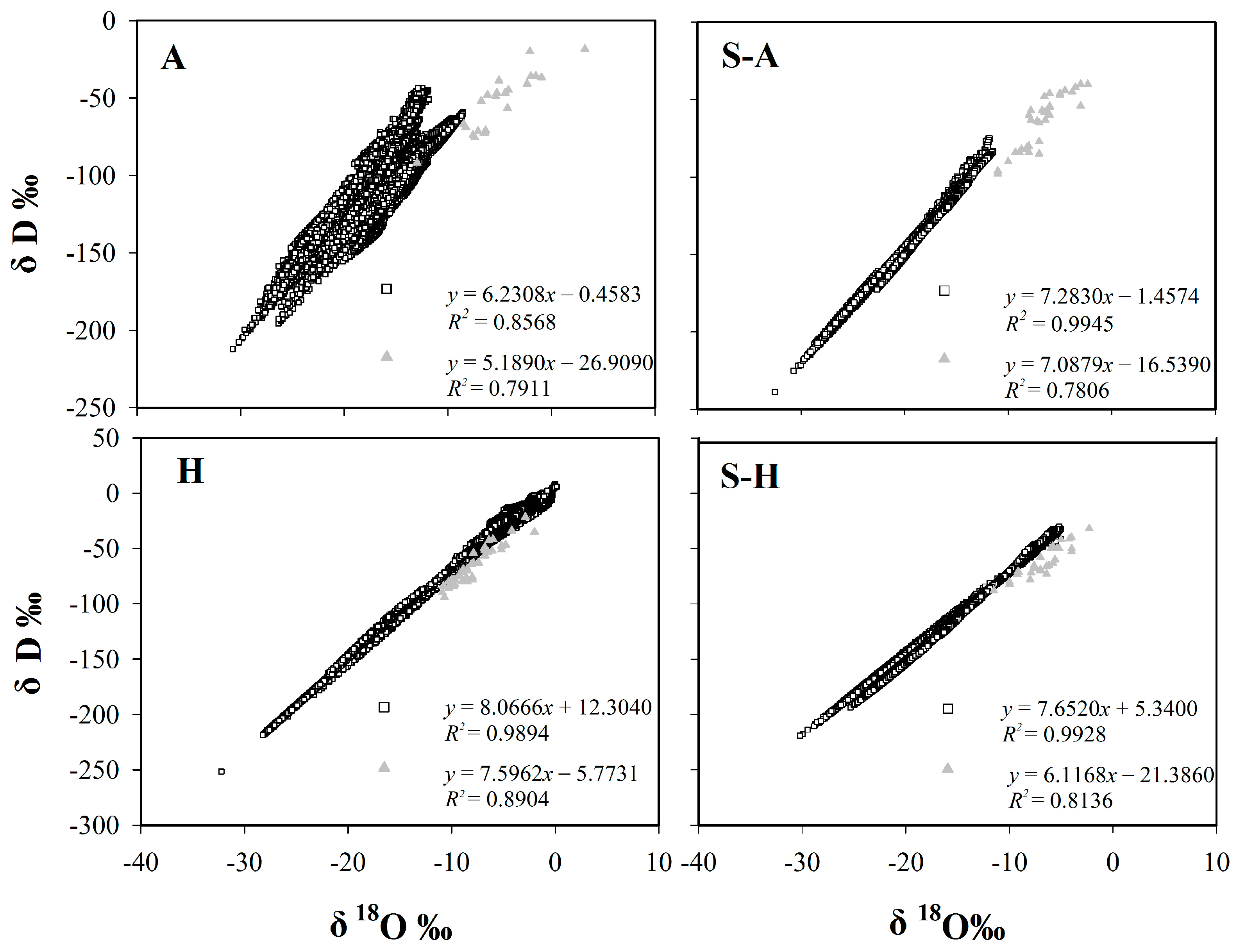
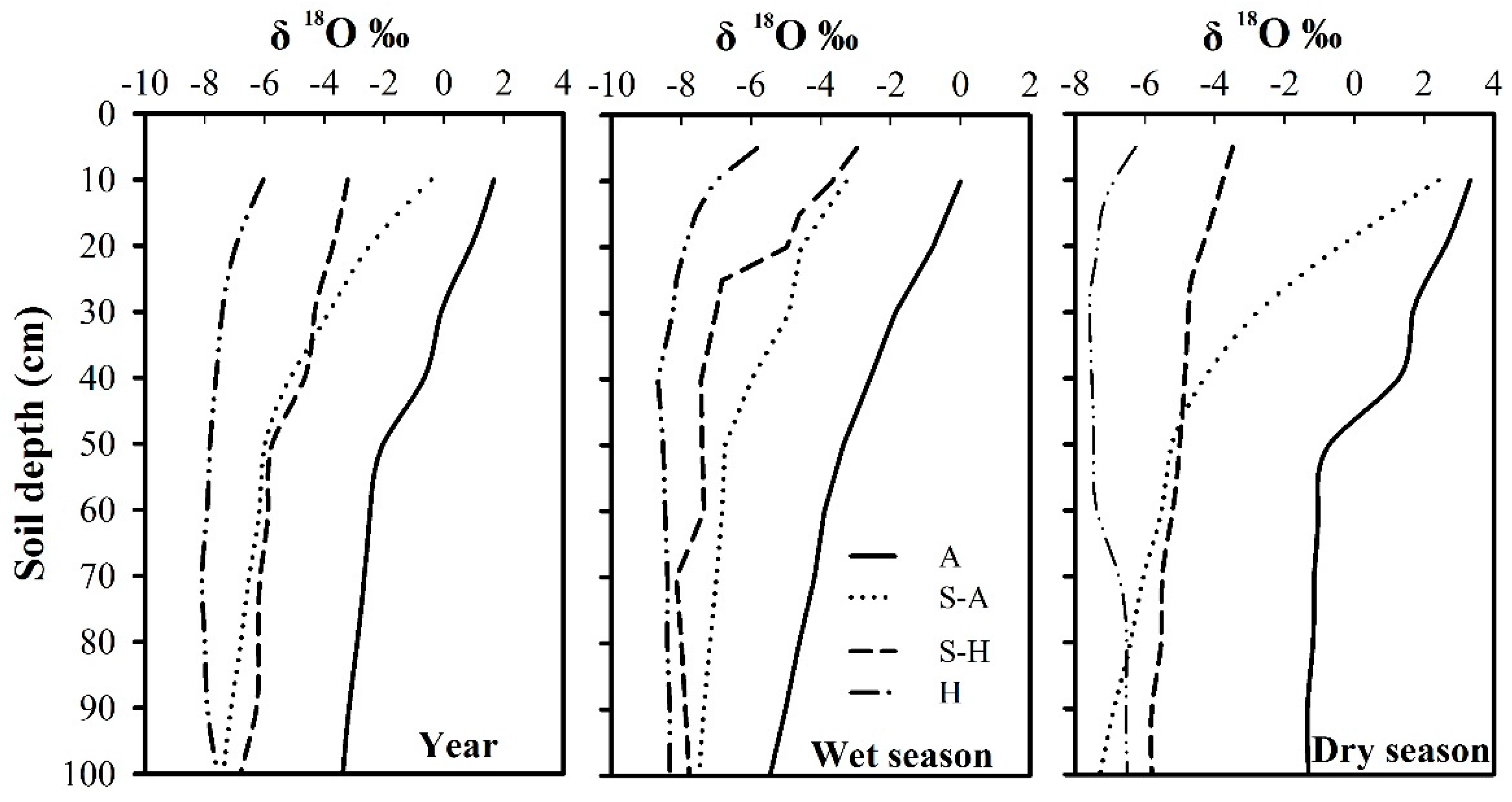


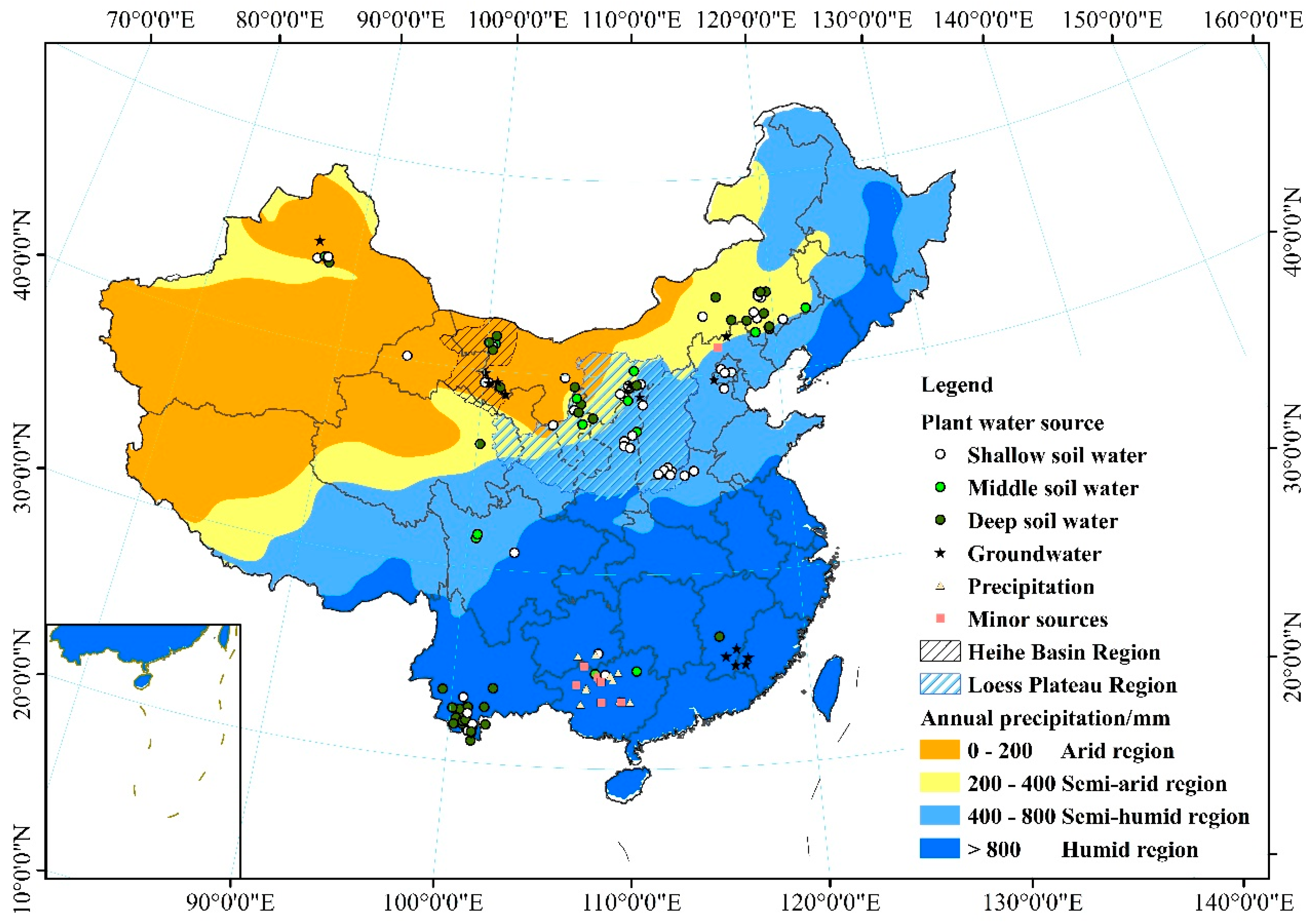
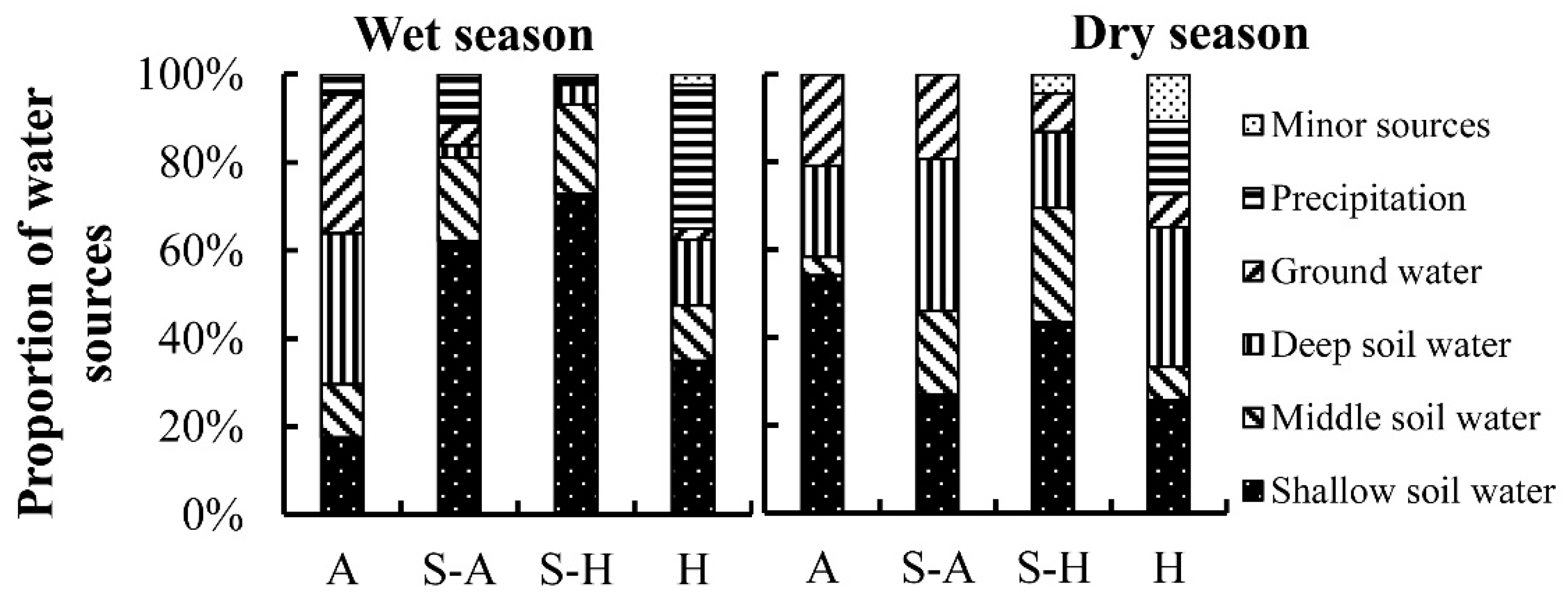
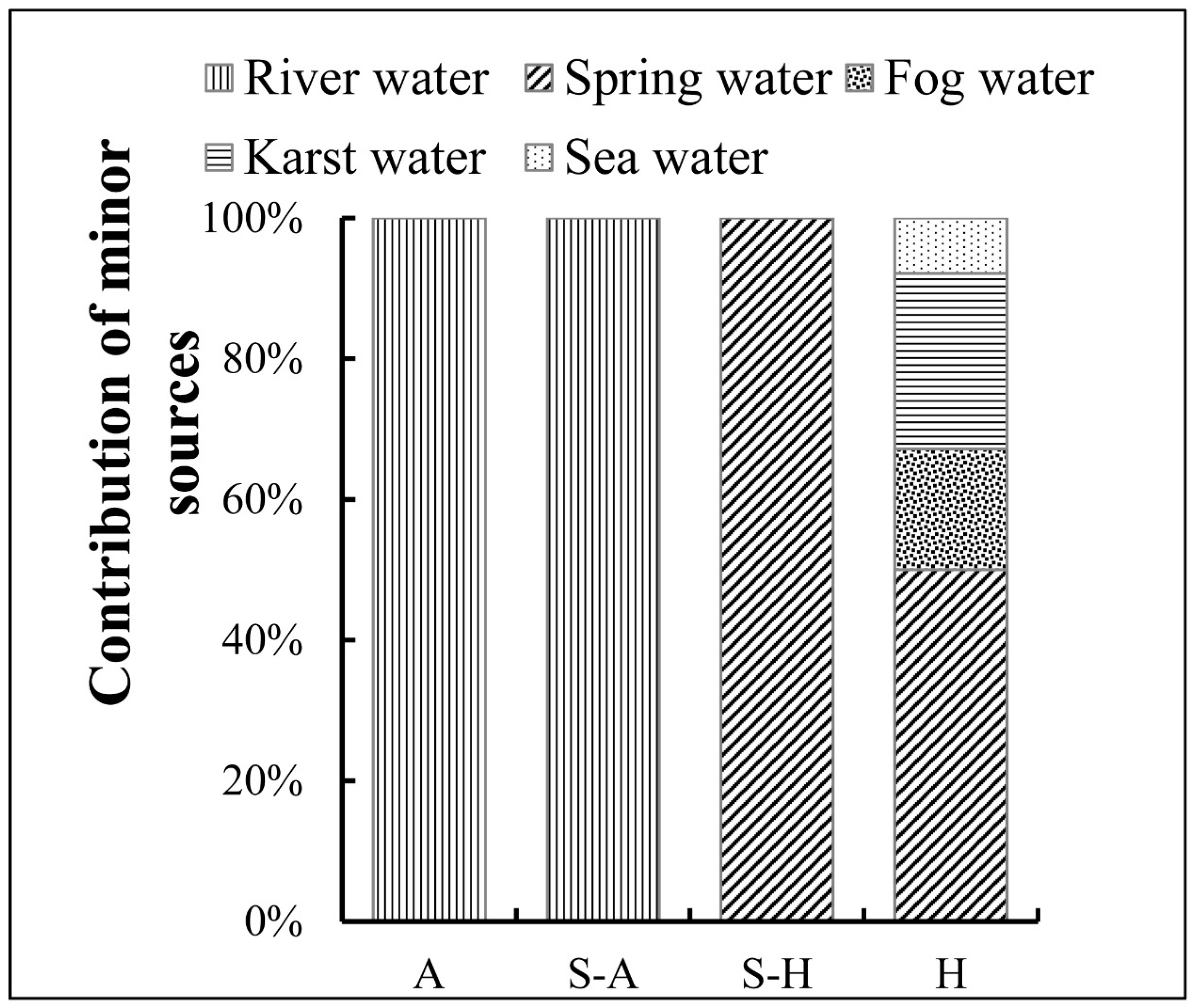

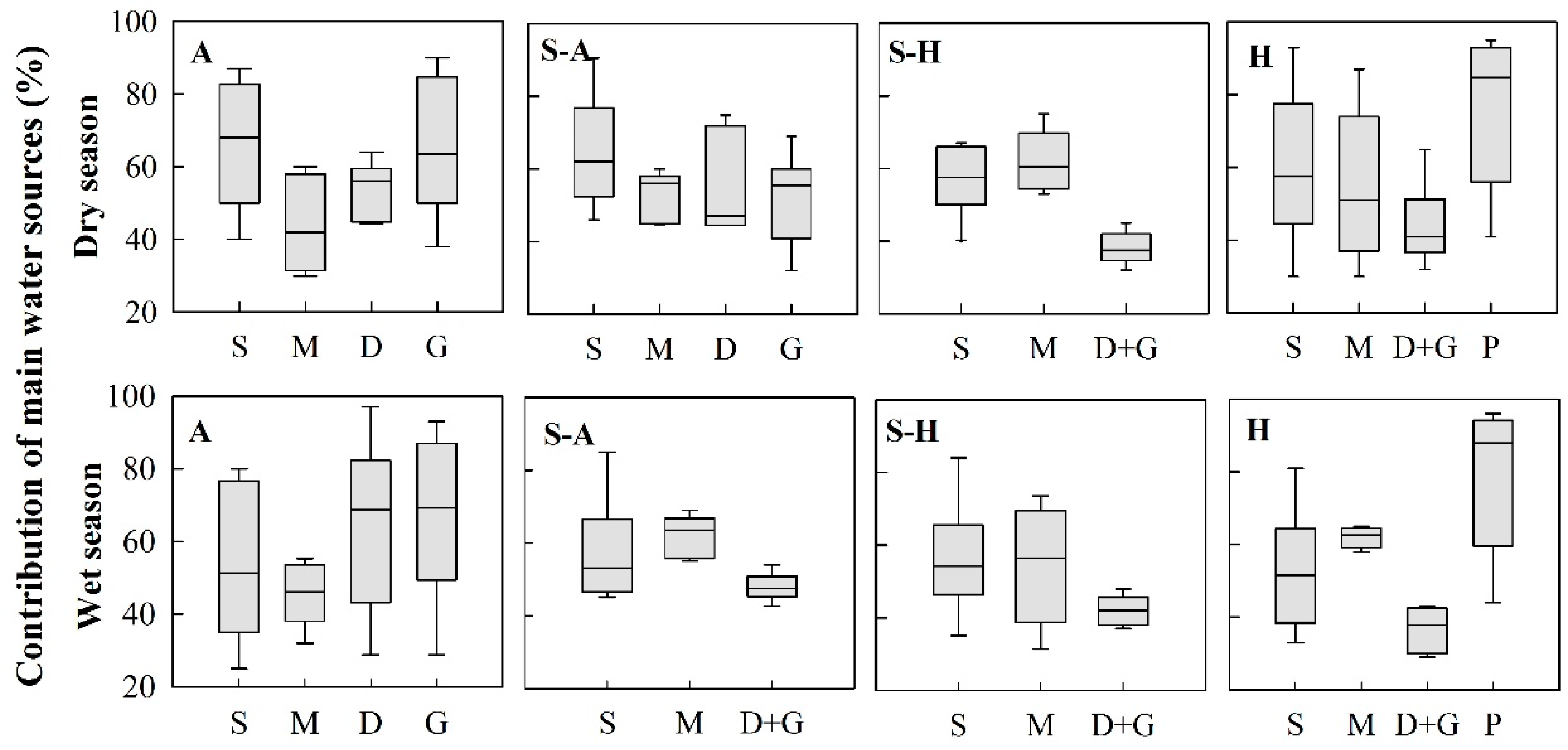
| Region | Equation | R2 | N | Range of δD (‰) | Range of δ18O (‰) |
|---|---|---|---|---|---|
| GMWL | δD = 8 δ18O + 10 | 400 | |||
| LMWL of China | δD = 7.9 δ18O + 8.2 | 0.977 | 107 | ||
| LMWL of A | δD = 6.231 δ18O − 0.458 | 0.859 | 10,397 | −212~−43.6 | −30.79~−8.56 |
| LMWL of S-A | δD = 7.283 δ18O − 1.457 | 0.995 | 4888 | −238.5~−75 | −32.5~−11.4 |
| LMWL of S-H | δD = 7.652 δ18O + 5.34 | 0.993 | 9079 | −219.5~−29.9 | −30.2~−5.0 |
| LMWL of H | δD = 8.067 δ18O + 12.304 | 0.989 | 9240 | −251.5~8.1 | −32.23~0.13 |
| PSWL of A | δD =5.189 δ18O − 26.909 | 0.791 | 23 | −92~−18.36 | −13~+3.2 |
| PSWL of S-A | δD =7.088 δ18O − 16.539 | 0.781 | 34 | −98~−40 | −11~−2.3 |
| PSWL of S-H | δD =6.117 δ18O − 21.386 | 0.814 | 30 | −88~−32 | −11.5~−2.3 |
| PSWL of H | δD =7.596 δ18O − 5.773 | 0.89 | 43 | −94~−21.5 | −10.9~−2 |
| Region | Previous Studies | The Preliminary Results of Cluster Analysis | Final Results | |||
|---|---|---|---|---|---|---|
| Author | Location | Classification/cm | Classification/cm | SED | Reclassification/cm | |
| A | Dai et al. (2015) | Gurbantonggut Desert | 0–40, 40–100, 100–300, | 0–10, 10–20, 20–40, 40–80, 80–100 | 5 | 0–40, 40–100, >100 |
| Zhou et al. (2017) | Badain Jaran Desert | 0–50, 50–150, 150–300 | ||||
| Zhang et al. (2017) | Heihe River Basin | 0–30, 30–80, 80–200 | ||||
| S-A | Yang et al. (2011) | Inner Mongolia | 0–20, 20–40, >40 | 0–10, 20–30, 30–60, 60–100 | 2.5 | 0–30, 30–60, >60 |
| Wu et al. (2016) | Tibet Plateau | 0–30, 30–60, 60–120 | ||||
| Zhu et al. (2014) | Ningxia plain | 0–40, 40–140, 140–200 | ||||
| S-H | Liu et al. (2017) | Huabei plain | 0–20, 20–60, 60–100 | 0–10, 10–20, 20–60, 60–100 | 5 | 0–20, 20–60, >60 |
| He et al. (2016) | Huabei plain | 0–30, 30–100 | ||||
| Lv et al. (2016) | Loess plateau | 0–10, 10–40, 40–80, 80–120 | ||||
| H | Rong et al. (2014) | karst area | 0–10, >10 | 0–5, 5–10, 10–40, 40–100 | 5 | 0–10, 10–40, >40 |
| Gu et al. (2015) | karst area | 0–5, 5–30, 30–50, 50–90 | ||||
| Yang et al. (2015) | Jitai Basin | 0–20, 20–50, 50–100 | ||||
© 2018 by the authors. Licensee MDPI, Basel, Switzerland. This article is an open access article distributed under the terms and conditions of the Creative Commons Attribution (CC BY) license (http://creativecommons.org/licenses/by/4.0/).
Share and Cite
Zhao, Y.; Wang, L. Plant Water Use Strategy in Response to Spatial and Temporal Variation in Precipitation Patterns in China: A Stable Isotope Analysis. Forests 2018, 9, 123. https://doi.org/10.3390/f9030123
Zhao Y, Wang L. Plant Water Use Strategy in Response to Spatial and Temporal Variation in Precipitation Patterns in China: A Stable Isotope Analysis. Forests. 2018; 9(3):123. https://doi.org/10.3390/f9030123
Chicago/Turabian StyleZhao, Ying, and Li Wang. 2018. "Plant Water Use Strategy in Response to Spatial and Temporal Variation in Precipitation Patterns in China: A Stable Isotope Analysis" Forests 9, no. 3: 123. https://doi.org/10.3390/f9030123





